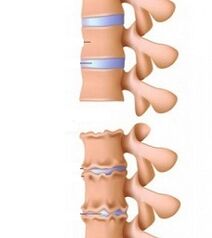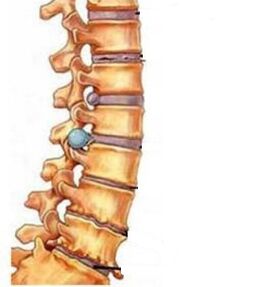
Osteochondrosis in the cervical area is a disease that violates metabolic processes, namely the accumulation of salt in the blood and lymph, which leads to pathological transformation of the structure of the joints between the intervertebral discs, vertebrae, vertebrae and vertebrae.Loss of elastic cartilage fabric contributes to the displacement of vertebrae, arterial clamping and other malnutrition changes.
Due to deformation of the joint, the height of the intervertebral disc is reduced.It should be noted that in the cervical area, the vertebrae are closer to each other than other parts of the spine, and therefore, the disc is in a healthy state.
Bone plants (bone growth) form on the sides of the vertebrae, which stimulates the muscles, causing their tension.Bone plants also squeeze the roots of the spinal cord, vertebral arteries and small blood vessels, from which brain cells cannot receive enough blood.Brain degradation and death.
According to the frequency of osteochondrosis in the second position of the neck twice.The first sign of this disease can occur before school age, and almost everyone observes it in one form or another.Among women aged 45-65, other symptoms occur during sleep and numbing backgrounds - tingling in the sleep area.
Causes of degeneration of the neck osteocartilage
Hypoemia - A long-term sitting lifestyle that mainly leads to cervical osteochondrosis.Often, their job involves people who live in long-term residences suffer: working on computers, office workers, drivers, etc.If a person is inappropriately poses, or if he has kept the body abnormal for a long time, osteocartilage degeneration should be expected, for example, holding a cell phone or phone on his shoulder.

Incorrect posture on the computer can lead to cervical bone and chondropathy!
Excessive stress on the back and neck can lead to excessive physical activity in the body, such as weightlifting.The same effect is achieved through incorrectly performed physical exercises.
Degradation and malnutrition in the cervical area are caused by constant nerve tone and stress, prolonged or temporary hypothermia, imbalance, insignificant nutrition, infection.
The increased risk group belongs to people with hereditary osteochondrosis, with defects in spinal development, traumatic spine or back.The danger is a chronic disease of the musculoskeletal system (rheumatism, scoliosis, systemic lupus erythematosus).The disease is favored by hormone imbalance, overweight, flat feet and progressive disco.
The main symptoms of cervical osteochondrosis and their factors
The key symptom of osteochondrosis is neck occipital pain.If the nerve roots are affected, the pain will extend to the shoulders, forearms.Muscle spasms and blood circulation are damaged, and pain is felt in the ears, eyes, teeth, and forehead.It can give shoulder blade, chest, gallbladder, lower back.Even with minimal load, long tilt, tilt or head turn, the feeling of pain increases.The pain basically manifests itself after sleep and will disappear if you develop muscles.Frequent sectors occur - acute pain, coupled with muscle sclerosis and difficulty in movement.

Numbness occurs in the arms and legs, burns and stings.The damaged root of the engine nerve weakens the strength of the muscles in the limbs.Blood pressure will rise and cheer up.
The neck department has delicate intervertebral discs, bone plants on the vertebrae, which affects the squeaking vertebrae joints and sit-ups if you suddenly throw it or turn your head.
Tension arteries and worsening blood supply to the occipital and cerebellar occipital bones of the brain can lead to neurotic diseases, which manifest in forms of irritability, anxiety, emotions, dissatisfaction and insomnia.Anger, anorexia, fear, craving burst.
For the same reason, the tongue and fingertips are numb, the sound is gasping, hearing and vision are reduced, the rustling in the ears, the eyes are darkened, and fainting occurs.Almost always, especially in women, if you turn your neck sharply, you will observe continuous headaches and even stronger.
The affected vestibular device leads to disorientation, coordination, dizziness and nausea in the space and vomiting associated with these phenomena.
Developmental stages of neck osteochondrosis
Cervical osteochondrosis develops under obvious circumstances, and each stage has its own clinical situation.
During the first stage (preclinical), the muscles are slightly tense, the pain is weak, and it increases when you turn or tilt the head.Rapid fatigue in the spine and waist muscles is characteristic.At this stage, the disease does not require medication.

The second stage occurs when the height drops in the intervertebral disc and clamping of the nerve ends.Injuries to the shoulders and hands except the neck.Fast fatigue, headaches, distractions occur, work is difficult, and performance is reduced.
The third stage marks the formation of hernia in the intervertebral disc.The muscles of the hand are then weakening and numbing, and the persistent pain will extend to the arms or shoulders.The general weakness is accompanied by dizziness.
In the fourth stage, the vertebral artery is affected and the damaged disc is replaced by connective tissue.Coordination is disturbed, severe dizziness, and the noise in the ears is worrying.
By type and symptoms of cervical osteochondral disease that affects vertebrae
Several types of cervical osteochondral disease are distinguished.
- Rook syndrome- Due to clamping of nerve ends, high-intensity pain covers the shoulders, forearms, shoulder blade bones and lower back, in addition to the neck.
- Driven arterial syndrome- It's the difference is a headache in the back of the head or temple.
- Stimulating - Reflex Syndrome- Burning pain in the neck and back of the neck can be applied to the chest and shoulders, which can be exacerbated when coughing in a dream.
- Heart syndromeOccurs due to spinal damage to the diaphragm bone nerve or large chest muscles.The urgent pain occurs in the heart of the heart, and they last for several hours and are exacerbated when you move or take a deep breath.
Failure of different cervical spines is manifested by their symptoms.
The striking first and second cervical spine (CI-II) can cause pain in the nape of the neck and crown.The nerve root (C3) causes numbness in the neck, reduced sensitivity to the tongue, and disturbed speech.If the neurospine of C4 is affected, the clavicle or shoulder is numb, and breathing is disturbed, heart pain will occur.The fifth department vertebrae dispersion violates the sensitivity of the arms and legs and pain on the shoulders.Compression of C6 and C7 is accompanied by pain in the neck, forearm, blade, lower back and back, and generally, the sensitivity of hands and fingers is reduced.The affected C8 nerve roots can stimulate pain in the neck, back, elbows and lower limbs.The little fingers are numb in the hands and the sensitivity of the skin drops to zero.As blood flow weakens, legs and hands become cyanide.
Diagnosis of cervical osteochondral disease
Diagnosis of cervical osteocartilage degeneration begins with collecting information about a person’s lifestyle and work, analysis of complaints and symptoms, and also finding out whether the disease is targeted at relatives.
The back and neck are then examined externally in different positions, which allows you to see if the posture exists.Palpation of pain areas reveals the level of pain and tension in muscles and vertebrae.
The main role in diagnosis is played through instrumental research methods.
The longest instrumental method - X-RAR allows you to identify general conditions of vertebrae and vertebrates, but in the later stages of the disease, it is ineffective.
Computed tomography has better diagnostic capabilities, but this approach does not allow a complete understanding of the presence and size of disc hernia.It is not clear whether the hernia in the spinal cord is compressed.
Magnetic resonance imaging (MRI) shows the highest efficiency.Not only is bone formation perfectly tracked, but other important structural elements of the spine: intervertebral discs, hernia, their parameters and how they develop.Under what conditions are soft fabrics, it is obvious.Ultrasound double scans of vertebrae allow you to understand their structure, the smooth blood flow, and the violations and abnormalities of the walls.
Once the disc damage and its degree of violation has been established, you can prescribe appropriate treatments.Otherwise, not only will osteocartilage progress, but different complications may occur.
Complications of cervical osteochondrosis
Complications of cervical osteochondrosis are caused by:
- intervertebral disc, nerves, nerve endings, plexus (neurological diseases);
- spinal cord;
- brain.
The tightly placed nerve ends and blood vessels are compressed in slight interference, which in turn disrupts the brain circulation and causes many diseases and diseases: migraines, hypertension, heart disorders, heart disorders, hearing, vision, vision, and attention coordination will occur.
Neglected cervical osteochondrosis is full of developments in vertebral syndrome, cerebral ischemia, spinal cord stroke and other deadly pathology.Radiculopathy leads to a complete or partial loss of sensitivity and mobility in the body.Squeezing the spinal cord can lead to fatal results.
Treatment of osteochondral disease in the spine
Using degenerative lesions of the disc, I use different treatments based on the symptoms.
Drug treatment for cervical osteochondrosis
The experts in osteochondrosis are neuropathologists, and the experts in the direct spine are vertebralists.
Medication treatments are designed to eliminate pain, relieve inflammation, improve blood circulation, and support the entire body.
The most disturbing syndrome - severe, sometimes unbearable pain that can be removed using non-replacement anti-inflammatory drugs (NSAIDs).The same medication relieves sterile inflammation and swelling at the damaged nerve roots.If the pain is weak, it is sufficient for pain medication.
You should know that most NSAIDs can have a negative impact on the mucosa of the stomach, so taking them for a long time is not recommended.
Anesthetize and simultaneous heating of affected areas may be ointments and gels.Pepper can be pasted to a sore area, but its effects are limited to heating and inflamed areas.
Injection of diuretics and herbs is suitable for combating edema.
In the treatment of cervical osteocartilage, B vitamins (B1, B6, B12) are sure to be used.Vitamins in this group improve metabolic processes in neural tissues.Effective oral tablets and intramuscular administration solutions are effective, but injections are painful and may have complications.
The most important treatment task is cartilage recovery of the intervertebral disc.It is solved with cartilage protectors.It must be kept in mind that all these drugs are bioactive additives with vague effectiveness.
The pathological characteristics require the use of drugs that improve blood properties, blood flowing to the brain, and nutritional effects of damaged nerve roots.
Muscle cramps can be eliminated by resorting to muscle relaxants.
Drugs introduced into the body through intramuscular injection will affect the nerve ends more quickly.The blocks are performed directly in the affected area, which quickly provides the desired effect.
The duration of certain medications depends on the stage of osteochondrosis, the patient’s complaints and their associated illnesses.
Physical Therapy Procedures

No failure in the treatment of cervical osteochondrosis includes physical therapy procedures.
Under the influence of current (electrophoresis), the drug immediately enters the site of damage.
The effect of ultrasound anesthesia can reduce inflammation and improve metabolic processes.Magnetic therapy can relieve tissue edema and thus reduce pain.Laser therapy has anti-inflammatory effects and improves blood circulation.
Massage of cervical straps is very useful in order to improve the blood supply to the brain.Treatment exercise occupies a special place for cervical osteochondrosis, especially when numbness of the limbs is observed.The patient's condition is improved by improving blood circulation and reducing muscle stress.In the acute stage of the disease, gymnastics is not recommended and should be performed during the recovery process.
If conservative treatment does not achieve positive results within 6 months, the pain will not pass, the nerve roots will not recover or bone marrow disease, and you can resort to surgical intervention.
Because there is no root cause of osteocartilage, in most cases it is a sedentary, sedentary lifestyle and medication will have a short-term effect.For irrevocable recovery, regular physical exercise and nutrition are required without causing the development of the disease.
Treatment of cervical osteochondral disease by folk methods
To treat cervical osteochondrosis, products of animal and plant origin were used.They can be taken inside and applied outside.

For internal use, you can prepare celery, a bay made of 4-5 grams of plants, with a liter of boiling water on top and stick to it for 2-4 hours.
Can be from:
- Honey (1-2 teaspoons) and mummy;Heat, place on warm wool fabric and connect to affected areas of the spine at night;
- nonsenseGrind the roots onto the grater, heat a little, wrap in gauze to apply to the sore spots, and tie it up with a warm cloth to keep the heat;
- Berdock(Rinse the leaves with hot water, apply on sore spots, and then wrap with bandages to replace with new leaves when the leaves are dry).
For friction, you can use chamomile and oil (preferably olives), although sunflowers are also suitable.Boil 30g of flowers and 0.5 liters of oil, persist for 2 days, tired and apply to the sore area.In chamomile you can add St. John's wort, diamond thread, Celandine.
For the same purpose, you can prepare soups of dandelion, birch buds, mint, coriander leaves (combine the mixture with steep boiling water to a 1:1 ratio of 1:1, stick to one hour after rubbing, apply a warm bandage).A method to rub from calendula (50g of flowers poured 0.5 liters of vodka, stick to 2 weeks).
In order to get rid of the symptoms of osteochondrosis, water ches- Hirudotherapy has been used for a long time.In the early stages, 6 meetings are enough.But water ech can cause allergies, and of course stop treatment.
Folk therapy can only show effectiveness in the initial stages of the disease, and if the disease progresses, the basis of treatment should be the drug method.
Prevent osteochondral disease in the cervical vertebrae
The main preventive measures for this disease are physical exercise (including walking, swimming) and gymnastics (aerobic exercise, yoga), but you cannot over-severely.Bodybuilding may cause herniation of the cervical disc.The support of the proper weight level is full of this measure.While sitting, you need to monitor your posture and rub your neck every 2 hours after a five-minute break.But rapid head movements should be avoided.If you massage regularly, you can prevent excessive muscle tone from developing.

Foods should be rich in vitamins, minerals (calcium, magnesium) and other beneficial substances.Porridge, eggs, legumes, mushrooms, low -fat meat are recommended (beef, chicken, rabbit), seafood (fish, crabs, oysters, lobsters, mussels), dairy products (milk, cottage cheese), fresh fruits, fresh vegetables (cabbage, carrots, eggplant, tomatoes, cucumbers, pepper, beets, bow, bow, bow, bow, bow, bow, bow,弓,弓,弓,弓,弓,弓,弓。
If neck osteochondrosis is accompanied by atherosclerosis, it is necessary to limit the use of products containing cholesterol - animal fat, fatty meat, fatty milk products.Limited consumer products also include flour products, sugar, and salt.
Alcohol is harmful because falling into the blood can destroy cells, which worsens the already poor blood circulation.Smoking is also a ban.
To protect osteochondrosis, stress must be avoided.Perform healthy sleep to prevent the development of the disease.You need to sleep on a sturdy mattress and a low pillow, and your neck should not bend more than 15°.
Hot showers, sauna and bathroom help clear neck cramps.
If osteochondrosis tends to be prone to the doctor from time to time.



















